Welcome fellow guitar players! Today, we’re going to explore the vibrant and versatile F# 7th chord guitar. This essential chord, often simply called F sharp 7, is a member of the dominant 7th family, known for its rich, bluesy, and jazzy sound. Understanding and mastering the F#7 chord will significantly expand your musical vocabulary and allow you to play in a variety of styles.
The F#7 chord is built from four notes: F#, A#, C#, and E. These notes are derived from the intervals 1, 3, 5, and b7 of the F# major scale. If you’re curious about the music theory behind chord construction and how intervals work, exploring resources on guitar music theory can be incredibly beneficial. Dominant 7th chords like the F#7 are fundamental in genres ranging from blues and jazz to rock and even pop music. Learning about dominant guitar chords and their function in harmony will further enhance your understanding and application of the F#7 chord.
To truly grasp the F#7 chord, it’s helpful to understand the intervals that create its unique sound: the root (1), the major third (3), the perfect fifth (5), and the minor seventh (b7). These intervals give the F#7 its characteristic dominant quality. For a deeper dive into intervals and how they relate to the guitar fretboard, resources on fretboard intervals can provide valuable insights.
This guide will provide you with clear chord diagrams and fretboard patterns for the F#7 chord across various positions. These visual aids, combined with detailed explanations, will empower you to learn, understand, and confidently play the F# 7th chord guitar. So, if you’re ready to enrich your chord knowledge and add a new dimension to your guitar playing, let’s get started with the F#7!
Understanding the F#7 Chord
F#7 Chord Notes and Formula
The F#7 chord is constructed using these notes:
- F# – Root (1)
- A# – Major Third (3)
- C# – Perfect Fifth (5)
- E – Minor Seventh (b7)
The formula for a dominant 7th chord, which F#7 is, is: 1 – 3 – 5 – b7. This formula is consistent across all dominant 7th chords, only the root note changes.
Why Learn the F#7 Chord?
The F#7 chord is incredibly versatile and appears in numerous musical styles. You’ll find it prominently featured in:
- Blues: Blues music heavily relies on dominant 7th chords for its characteristic sound. The F#7 is a common chord in blues progressions.
- Jazz: Jazz harmony frequently uses dominant 7th chords, and F#7 is no exception. It adds color and sophistication to jazz chord progressions.
- Rock and Pop: While perhaps less common than in blues and jazz, the F#7 chord can be found in rock and pop music to add a bluesy or jazzy flavor, or as a transitional chord in more complex progressions.
F#7 Chord Positions on the Guitar
Here are several positions to play the F# 7th chord guitar, ranging from easier movable shapes to barre chord forms.
Movable Positions
These positions are movable, meaning you can shift them up or down the neck to play different 7th chords. The root note will change as you move the shape.
Position 1 (Movable)
This is a common and relatively easy movable shape for the F#7 chord. The root note in this position is on the 6th string.
 F# 7th chord position 7 diagram, movable shape with root on the 6th string, common voicing for F sharp dominant 7th chord on guitar
F# 7th chord position 7 diagram, movable shape with root on the 6th string, common voicing for F sharp dominant 7th chord on guitar
Position 2 (Movable)
This is another movable shape, often used higher up the neck. The root in this position is on the 5th string.
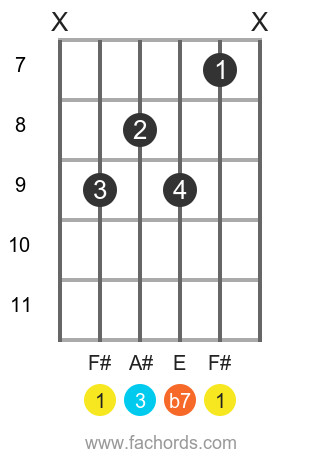 F# 7th chord position 2 diagram, movable shape with root on the 5th string, alternative voicing for F sharp dominant 7th chord on guitar
F# 7th chord position 2 diagram, movable shape with root on the 5th string, alternative voicing for F sharp dominant 7th chord on guitar
Position 3 (Movable)
This movable position offers a fuller sound and is rooted on the 5th string as well, but played in a different area of the neck.
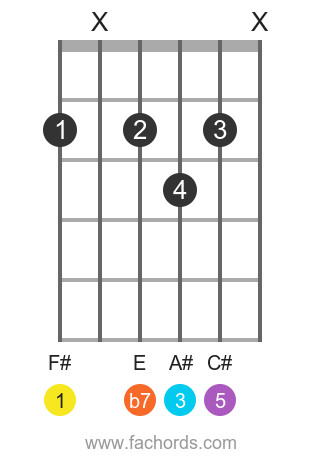 F# 7th chord position 5 diagram, movable shape with a fuller sound, F sharp dominant 7th chord voicing with root on the 5th string
F# 7th chord position 5 diagram, movable shape with a fuller sound, F sharp dominant 7th chord voicing with root on the 5th string
Barre Chord Positions
Barre chords can be more challenging but provide solid and powerful voicings of the F#7 chord across the neck.
Position 4 (Barre, Movable)
This barre chord shape is based on the E shape barre chord and is movable.
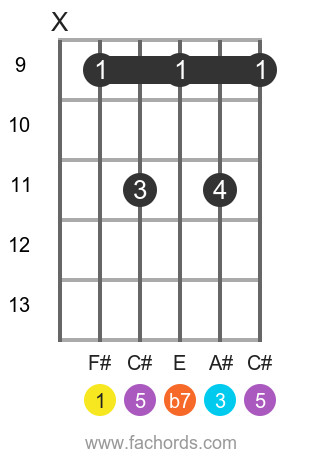 F# 7th chord position 3 diagram, E shape barre chord for F sharp dominant 7th, movable barre chord voicing
F# 7th chord position 3 diagram, E shape barre chord for F sharp dominant 7th, movable barre chord voicing
Position 5 (Barre, Movable)
This barre chord shape is based on the A shape barre chord, another movable and versatile form.
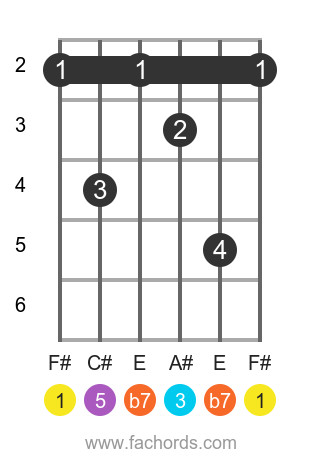 F# 7th chord position 1 diagram, A shape barre chord for F sharp dominant 7th, movable barre chord voicing for guitar
F# 7th chord position 1 diagram, A shape barre chord for F sharp dominant 7th, movable barre chord voicing for guitar
Position 6 (Barre, Movable)
This barre chord position provides a different voicing, rooted on the 6th string and using a variation of the barre shape.
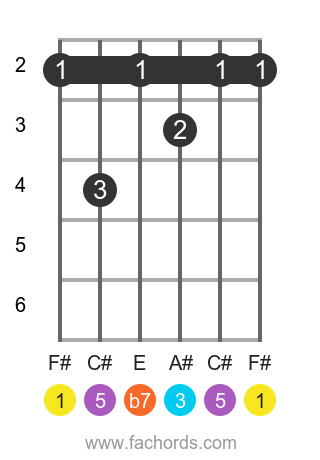 F# 7th chord position 4 diagram, alternative barre chord shape for F sharp dominant 7th, movable voicing with root on 6th string
F# 7th chord position 4 diagram, alternative barre chord shape for F sharp dominant 7th, movable voicing with root on 6th string
Tips for Practicing F#7 Chord Transitions
Smooth chord transitions are crucial for fluid guitar playing. When practicing the F#7 chord:
- Start Slow: Practice changing to and from the F#7 chord slowly and deliberately.
- Focus on Cleanliness: Ensure each note of the chord rings out clearly.
- Use a Metronome: Gradually increase your tempo as you become more comfortable with the transitions.
- Practice Common Progressions: Incorporate the F#7 chord into common chord progressions to practice in a musical context.
Expanding Your F#7 Chord Vocabulary
Using the Fretboard Map
The fretboard map below shows the locations of the notes of the F#7 chord across the fretboard. Use this map to explore different voicings and inversions of the F#7 chord. Experiment with picking out different combinations of these notes to create your own unique F#7 chord sounds.
[Fretboard map image would be inserted here if available in the original article – Note: Original article did not have a fretboard map image. If it was available, it would be inserted here with alt text describing the F#7 notes on the fretboard]
Conclusion
The F

